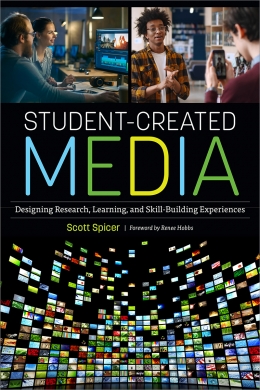Primary tabs
You don't need to be an ALA Member to purchase from the ALA Store, but you'll be asked to create an online account/profile during the checkout to proceed. This Web Account is for both Members and non-Members.
If you are Tax-Exempt, please verify that your account is currently set up as exempt before placing your order, as our new fulfillment center will need current documentation. Learn how to verify here.
- Description
- Table of Contents
- About the author
- Reviews
Foreword by Renee Hobbs
This book will guide librarians, learning technologists, and their faculty partners in designing assignments for authentic learning and supporting students in multimedia production.
Reinforcing the ACRL Framework’s calls for information creation in a range of formats, a 2020 LinkedIn survey rated “video production” as a top 10 skill sought by employers. Your library has an opportunity to partner with faculty to foster student-created media, which can be the perfect showcase for students’ ideas, research, subject knowledge, and media literacy skill set development. Building on his work supporting student media projects for more than 400 courses, Spicer walks you through
- 5 case studies complete with learning objectives, student feedback, extracurricular views, and more, plus approaches to media creation workshops from four universities;
- 21 questions to guide assignment development consultations with faculty;
- an overview of common genres such as documentary, video investigation, and personal narrative, with pointers on when to use them;
- applying the 7 steps of digital storytelling;
- topics to cover when presenting the assignment to a class;
- recommended media creation equipment for circulation;
- the benefits of sharing student work on streaming platforms;
- developing effective individualized student media creation support services, either in-person or virtually;
- ways to showcase student work in online galleries; and
- examples of the enduring impact of student media projects.
Foreword by Renee Hobbs
Preface
Acknowledgments
Chapter 1 Media Literacy Applied through Course-Integrated, Student-Created Media Projects
Chapter 2 Media Assignment Development
Unlocking the Potential for Learning
Chapter 3 Media Project Genres
Chapter 4 Course Outreach
Chapter 5 Media Creation Equipment and Software
Chapter 6 Research, Technical, and Compositional Support
Chapter 7 Video Investigation and Solutions Modeling
Ecosystem Health Grand Challenges—A Case Study
Chapter 8 Personal Narrative Digital Story
Reflections on Service Learning—A Case Study
Chapter 9 Public Service Announcement
A Collaboration on Maternal Nutrition—A Case Study
Chapter 10 Video Investigation
Historic Preservation—A Case Study
Chapter 11 Documentary-Style Digital Story
The Relationship Between Place, Culture, and Identity—A Case Study
Chapter 12 Visibility with an Eye toward the Future
Index
Scott Spicer
Scott Spicer serves as Media Outreach Librarian for the University of Minnesota Libraries (Twin Cities), where he functions as head of the Libraries Media Services program. His primary responsibilities include outreach to instructors on the development and support for course integrated student produced media assignments and commercial educational media resources. He has studied, published, and presented on a diverse range of media related topics in higher education, including the benefits and library support of student produced media, educational media resources, media literacy skill set development, and multimodal scholarship with additional interests in emerging technologies. A former chair of ALA’s Film and Media Round Table, he holds an M.L.I.S from Dominican University and an M.A. in Curriculum and Instruction-Learning Technologies from the University of Minnesota.
"Scott Spicer has created a concise yet voluminously informational guidebook for the establishment of a rigorous academic student media production program appropriate for the academic library media center professional. However, beyond this, Mr. Spicer’s book can and should be read by any instructor interested in developing a highly effective learning experience in 21st Century skills, the rhetoric of visual media design, and the subject-area content of their discipline ... This book is a valuable addition to an academic library collection for both library faculty and instructors of disciplines in which sourced writing and creative knowledge expression are important."
— Public Services Quarterly
"Media literacy has the power to improve students’ analytical thinking, creativity, analysis, and complex problem-solving. These skills benefit students beyond the classroom, as current employers want and need them ... Libraries of all sizes can take advantage of the enthusiasm for rich opportunities that media projects afford with a library’s involvement."
— Journal of Web Librarianship



